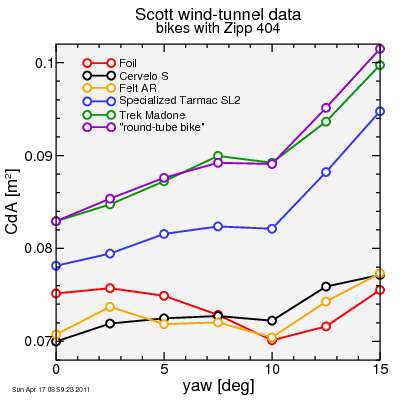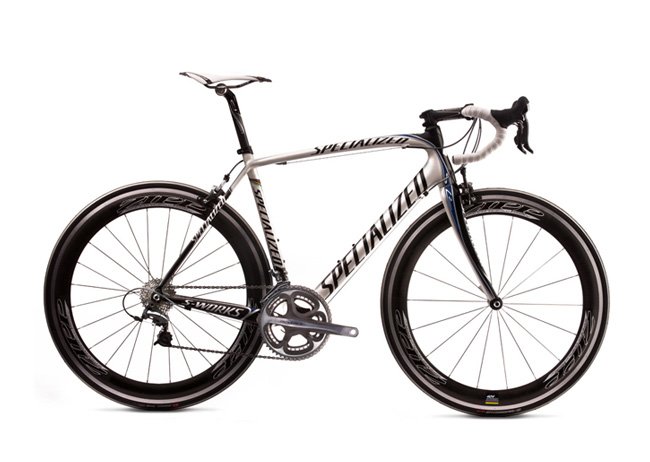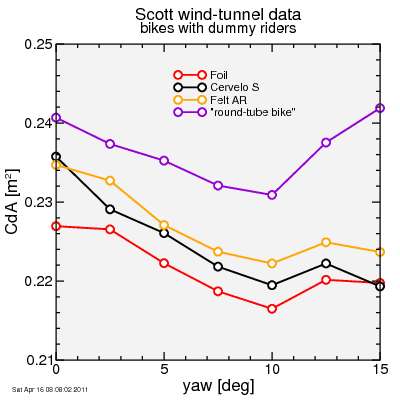Scott Foil wind tunnel test of aero mass-start frames
Scott just released a new bike, the "Foil", their entry into the "mass-start aero frame" category.
This bike has been around in the pro peloton for a year now. Mark Cavendish famously rode it in the first stage of last year's Tour de France, where he had a disappointing result. When he switched back to his previous bike, a beefed-out Scott Addict (the consumer Addict is under 800 grams, Mark's custom bikes are reportedly close to 1200 grams with a Pinarello-like excess of carbon fiber), he started winning races again. But the rest of his HTC Columbia team continued to ride the bike, including Mark Renshaw and the rest of the lead-out train on which Mark relies so heavily for his wins.
Interestingly, until this consumer release it has been called the F01. Very clever: the F01 becomes the F01L, or the "FOIL". Scott wins the bike naming game against Specialized with the latter's recently-released Venge.
The differentiating factor with the Scott is its "Kamm Tail" design. You can see Scott's website for plenty of info: basically they cut the tail off an aerodynamic shape, and since the flow of the wind has already been established by the tail, the air flows almost as smoothly over the shape than it would have with the tail still in place. The advantage is you save mass by leaving the tail off, and additionally attain UCI compliance. The UCI forbids frames to have more than a 3:1 aspect ratio (length to width) on any of the main tubes. (Apparently the ratio does not apply to quick release levers, for example). Here is their styled representation of the concept:

Their video shows their engineers apparently inventing the concept, but Trek has been using it for several years on their time trial frames.
Scott puts wind tunnel data up on their site to justify their claim that the frame is at least as good as the competition. So far in the tests I have reviewed, one by Tour Magazine and the other by VeloNews, the Felt AR and the Cervelo S have been compared. In the Tour test the Cervelo and Felt were fairly close, with the Felt better at zero yaw. This test was done with a dummy on the bike, but no cables installed. Then VeloNews published a test in which the Cervelo came out clearly ahead. This had the bikes fully built up except for pedals without a rider on board.
Here's Scott's data for its bike compared to the Cervelo, the Felt, and to three "non-aero" bikes, the Specialized SL2, the Trek Madone, and a "round-tubed bike" which I'd guess is the Scott Addict, or even more likely a Scott CR1 with its longer headtube. I first show the results with no dummy on the bike. I converted their data, described as power at 45 kph, to a CdA value assuming an air density at the Mercedes Wind Tunnel of 1.2 kg/m³.

This is exactly the sort of thing you might expect. The Cervelo and the Felt, designed with more traditional aerodynamic optimization, come out slightly better at low yaw than the Scott. At higher yaw the Scott does better. When the wind hits from more of a side angle the elongated aerodynamic tubes may provide more surface area for wind resistance.
All three finish well ahead of the Specialized SL2 and the Trek Madone, but interesting is that the Specialized does so much better than the Trek (and the "Round Tube Bike"). Here's a comparison of these frames:



I'm not sure I see why the Specialized did better than the others. Were the frames tested with seat posts? If not, maybe the swoopier top tube-seat stay transition helped. But since the Foil has an aerodynamic seat post, I suspect they were tested with seat posts. Did they test the Madone "performance" or "pro" fit? If the "performance", then maybe it's an issue of head tube length: the Madone and the Scott both having longer head tubes than the Specialized. I'm really not sure.
Here's the aero frames tested:



They also tested the bikes with "dummy" riders. I'm not sure if the frames had components installed or, if so, what components. Here is the results, which again I converted to CdA using the same assumed air density of 1.2 kg/m³:

These results are very different from the tests of the bare frames. The Scott Foil does clearly better than the Cervelo and the Felt. How is that possible? Without seeing photos of the dummy mounted on the bikes, I worry about how closely matched the rider positions were, and how the riders were placed in that position. So it would be difficult to speculate on this result.
This is getting long, so I'll save more more for later...
This bike has been around in the pro peloton for a year now. Mark Cavendish famously rode it in the first stage of last year's Tour de France, where he had a disappointing result. When he switched back to his previous bike, a beefed-out Scott Addict (the consumer Addict is under 800 grams, Mark's custom bikes are reportedly close to 1200 grams with a Pinarello-like excess of carbon fiber), he started winning races again. But the rest of his HTC Columbia team continued to ride the bike, including Mark Renshaw and the rest of the lead-out train on which Mark relies so heavily for his wins.
Interestingly, until this consumer release it has been called the F01. Very clever: the F01 becomes the F01L, or the "FOIL". Scott wins the bike naming game against Specialized with the latter's recently-released Venge.
The differentiating factor with the Scott is its "Kamm Tail" design. You can see Scott's website for plenty of info: basically they cut the tail off an aerodynamic shape, and since the flow of the wind has already been established by the tail, the air flows almost as smoothly over the shape than it would have with the tail still in place. The advantage is you save mass by leaving the tail off, and additionally attain UCI compliance. The UCI forbids frames to have more than a 3:1 aspect ratio (length to width) on any of the main tubes. (Apparently the ratio does not apply to quick release levers, for example). Here is their styled representation of the concept:

Their video shows their engineers apparently inventing the concept, but Trek has been using it for several years on their time trial frames.
Scott puts wind tunnel data up on their site to justify their claim that the frame is at least as good as the competition. So far in the tests I have reviewed, one by Tour Magazine and the other by VeloNews, the Felt AR and the Cervelo S have been compared. In the Tour test the Cervelo and Felt were fairly close, with the Felt better at zero yaw. This test was done with a dummy on the bike, but no cables installed. Then VeloNews published a test in which the Cervelo came out clearly ahead. This had the bikes fully built up except for pedals without a rider on board.
Here's Scott's data for its bike compared to the Cervelo, the Felt, and to three "non-aero" bikes, the Specialized SL2, the Trek Madone, and a "round-tubed bike" which I'd guess is the Scott Addict, or even more likely a Scott CR1 with its longer headtube. I first show the results with no dummy on the bike. I converted their data, described as power at 45 kph, to a CdA value assuming an air density at the Mercedes Wind Tunnel of 1.2 kg/m³.

This is exactly the sort of thing you might expect. The Cervelo and the Felt, designed with more traditional aerodynamic optimization, come out slightly better at low yaw than the Scott. At higher yaw the Scott does better. When the wind hits from more of a side angle the elongated aerodynamic tubes may provide more surface area for wind resistance.
All three finish well ahead of the Specialized SL2 and the Trek Madone, but interesting is that the Specialized does so much better than the Trek (and the "Round Tube Bike"). Here's a comparison of these frames:



I'm not sure I see why the Specialized did better than the others. Were the frames tested with seat posts? If not, maybe the swoopier top tube-seat stay transition helped. But since the Foil has an aerodynamic seat post, I suspect they were tested with seat posts. Did they test the Madone "performance" or "pro" fit? If the "performance", then maybe it's an issue of head tube length: the Madone and the Scott both having longer head tubes than the Specialized. I'm really not sure.
Here's the aero frames tested:



They also tested the bikes with "dummy" riders. I'm not sure if the frames had components installed or, if so, what components. Here is the results, which again I converted to CdA using the same assumed air density of 1.2 kg/m³:

These results are very different from the tests of the bare frames. The Scott Foil does clearly better than the Cervelo and the Felt. How is that possible? Without seeing photos of the dummy mounted on the bikes, I worry about how closely matched the rider positions were, and how the riders were placed in that position. So it would be difficult to speculate on this result.
This is getting long, so I'll save more more for later...
Comments